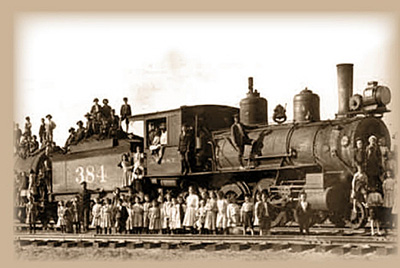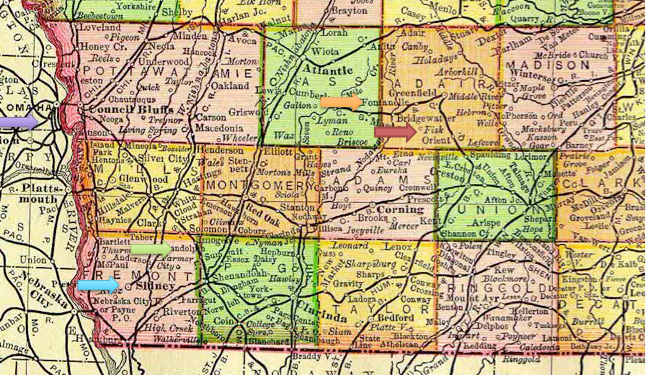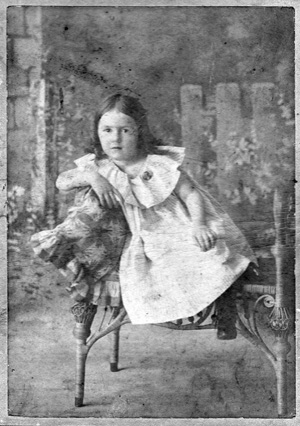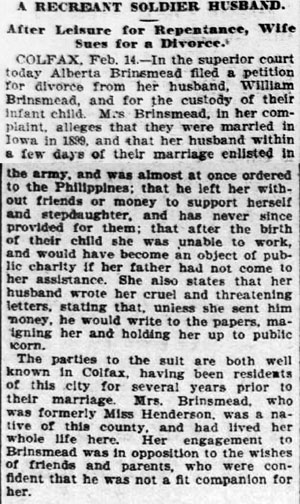William and Arthur Brinsmead in Iowa
 One of the Orphan Trains taking abandoned children West
One of the Orphan Trains taking abandoned children WestWilliam Brinsmead Snr., desperately sick and with only three weeks to live, gave William Jnr. and Arthur over to the care of the New York Children's Aid Society. William and Arthur were sent out to farms in Iowa on what became known as the Orphan Trains.
The Orphan Trains were part of a scheme that ran from 1853 to 1929 involving two major New York charities sending orphaned, abandoned and homeless children from the Eastern US to live with farm families in the newly settled Midwest. An interesting account of very similar circumstances with children sent with the same E.H. Trott, to Iowa, from the same part of New York just one year earlier, appears in an article published in the New York Daily Tribune.
Not all placements were pre-arranged. Sometimes the trains stopped at railway stations along the way and the children were selected (or not) by interested families. Siblings were often separated, as appears to have been the case with Arthur and William. Arthur would have been about eleven at the time and William about thirteen. They were placed about 20 miles apart in the southwest corner of the State.
A few years later, William and Arthur's sister Ella also came to Iowa although it appears that she came directly rather than through the Children's Aid Society. She lived in the small hamlet of Monroe in the Northeast corner of Fremont County. Ella's life is described on another page.
 South West Iowa showing William's location in Sidney, Fremont County, Ella's first home in Monroe, Fremont County, Arthur's homes in Fisk and Fontanele, Adair County and Fort Omaha, Nebraska.
South West Iowa showing William's location in Sidney, Fremont County, Ella's first home in Monroe, Fremont County, Arthur's homes in Fisk and Fontanele, Adair County and Fort Omaha, Nebraska.Arthur Brinsmead (1871-1894)
Arthur ended up on farms in Adair County, Iowa. The 1885 Iowa Census shows Arthur living with John A. Moore, age 44, his wife and their 15 year old son Alio. Arthur was 13 at that point.
The New York Children' aid Society provided the following information from their files on Arthur's life and untimely death:
Arthur Brinsmead, 10 England, H.Q. Goes West with E. Trott. Placed with J.A. Moore – Fisk P.O., Adair County, Iowa. Visited February 28, 1882 and on April 29, 1882, Mr. Moore writes that Arthur is going to school and is very happy. The (CAS) visitor wrote on July 20, 1883 that Arthur was well, going to school and is well satisfied. He would like to hear from his father. Visited by Mr. Fry (CAS staff member) February 1884, who reports Arthur is still in his place and is doing well. February 27, 1884, Arthur writes that he is well and likes his home very much. W November 19,1885 W February 28, 1889.
On March 13, 1889 Grant G. Oliphant, Fisk P.O., Iowa writes that Arthur is now making his home with Mr. M. Tiffany’s family, in Fontanella, Iowa. Mr. Oliphant also states that Arthur was seriously hurt while jumping from a horse on Monday, March 11th. The horse was running and Arthur in some way came in contact with a tree. He crushed his parietal bone on the right side very badly and also cracked his skull around to the base. Death may result at any time.
Mr. and Mrs. Tiffany are very fine people and are doing their utmost for him as far as kindness, treatment, etc. are concerned. Any aid that kind friends with willing hearts and money can bestow are given to him. Arthur has many warm friends who are willing and anxious to render any needed comfort. Mr. Oliphant wishes us to inform him of Arthur’s people. April 22, 1889. See attachment of William on page 153.
Arthur has recovered and is farming, March 12, 1890. William writes that Arthur is doing well. W. April 21, 1891. Letter of April 12 returned on May 15, 1891. Wrote May 10, 1894. August 25, 1894 Mr. D. Moyer of Fontelle [sic], Iowa, writes that Arthur died on the 22nd of August of diabetes. He was sick but 24 hours. During the last summer, he hauled milk to the creamery and lived with Mr. Moyer at the time of his death.
William Brinsmead (1869-1936)
William's later life, after he entered the US Army, married Andrea Ingebrigtsen and raised a family, is described on another page.
As with Arthur, the Children's Aid Society of New York was able to provide some early details of William's life:
 William Brinsmead Jnr. as a young man, circa 1886 probably taken in high school in either Guthrie County or Adair County, Iowa.
William Brinsmead Jnr. as a young man, circa 1886 probably taken in high school in either Guthrie County or Adair County, Iowa. [William] goes West with E.H. Trott (CAS staff member who took children to homes in the West). Placed with L.F. Morical, Sidney, Freemont County, Iowa. A home visit was made on January 14, 1882, and the initials of a CAS local visitor appears before July 20, 1883, meaning a home visit was made again. A letter was written December 5, 1889 and another on March 19, 1889 [sic]. (We don’t know if William wrote to CAS or visa versa).
On April 22, 1889, Mr. Morical wrote from Stuart, Iowa that William is a soldier and a musician in Company D, of the 2nd infantry at Fort Omaha, Nebraska. He enlisted for five years, has served two, and is well satisfied. He heard from Europe that his father is dead. William came to see his brother who was hurt, but has since recovered.
March 20, 1890, William writes that he is in the Army and likes it very well. He says any young man can do well if he behaves himself. Plays in the band and get(s) $13 per month. Says his brother is doing well.
W. October 20, 1891. W. November 12, 1895. Again, we don’t know who wrote, William or CAS. We suspect that William wrote to CAS to inform us how he was doing.
That is the extent of the record [for William].
William Jnr. had an early life filled with tragedy and uncertainty, including the loss of his mother, migration, separation from most of his siblings, being given up by his father in New York, and then the death of his brother. He appears to have remained unaware of his father's fate for almost nine years, itself a very unsettling experience for a young boy.
Given all this, it is not surprising that, during his early years, he had some difficulty achieving a stable personal life. Over a relatively short period, William went through two marriages. His first wife died prematurely. His second marriage was very short and was annulled. William had two daughters, one by each of those wives. It was only once he became established in his Army career and married Andrea Ingebrigtsen that his life settled down. That life is the subject of another page.
As the Children's aid Society details, William signed up for the Army at Fort Omaha, which was north of the Iowa farms upon which he had been working, and slightly west, just over the border in Nebraska. He was eighteen when he first enlisted, in the United States Army, 2nd Infantry, on October 1st, 1887. His musical upbringing obviously led him into the band from the earliest days of his army life. His instrument was the Cornet.
William's Marriage to Mary Lauless
 Ethel Brinsmead taken in June 1899, courtesy of Brian Huseland
Ethel Brinsmead taken in June 1899, courtesy of Brian HuselandWilliam's first marriage, which took place on October 15, 1892 before a County Official in the County Office in Douglas, Nebraska, was to Mary Lauless. The couple had a baby daughter named Ethel. Mary died in 1897 at Fort Keogh, Montana (near Miles City) where William was stationed after Fort Omaha. When Mary died, the daughter was placed in foster care and brought up by another family, although retaining the name Brinsmead. Mary is buried in O'Neill, Nebraska.
The 1910 census has an Ethel I Brinsmead living in Scott, Holt, Nebraska, listed as a niece of William and Sarah J. Welch who had a young family of four children.
We have no account of what happened to daughter Ethel after that date.
 A newspaper account, from
Alberta Brinsmead's perspective, of her divorce from William Brinsmead
A newspaper account, from
Alberta Brinsmead's perspective, of her divorce from William BrinsmeadWilliam's Marriage to Albertta Henderson
On April 26, 1899, at age 29, William married a second time, to Albertta Henderson, in Logan, Harrison, Iowa. She was 21 years old, the daughter of W. H. and Alice Henderson. Very soon after the marriage, William was posted to the Philippines. Albertta took steps to divorce or have the marriage annulled, but not before she was pregnant. On July 31, 1899, Albertta gave birth to a baby girl named Ernestine but apparently never told William. It was only many years later that Ernistine located William and his family living in Port Townsend and announced that she was his daughter.
The 1900 US census shows Albertta, age 22, living with her parents in Cottonwood Precinct, Whitman County, Washington State.
On September 11, 1901, Albertta remarried, to a Noble Ward Marsh, at Spokane's 2nd Congregational Church. That marriage too was apparently short lived, as Mr. Marsh married again, in Spokane on August 4, 1904 to Thursa Ola Nunn. Noble Ward Marsh died in Spokane on August 10, 1944.
Ernistine married on January 28, 1918 to M. Clayton Westfield of Yukima, Washington, who worked as a stockman. The 1920 census finds the couple living in Pilchuk, Snohomish, Washington.
In 1930, Ernestine married Noble Lottis Hendricks. THe wedding was at the Baptist Church at 423 11th Ave. N in Seattle. The 1930 census confirms the couple lived in Seattle. The 1932 Seattle directory shows her living under that name and working as a waitress. The 1940 census finds the couple still in Seattle with Ernistine still working as a waitress. It tells us she had a grade eight education. Noble Hendricks died on January 21, 1949 in Yakina. She died on August 2, 1987 also in Yakima, apparently without remarrying.
